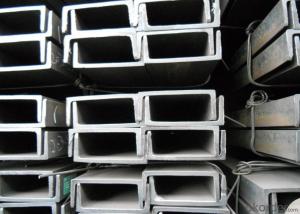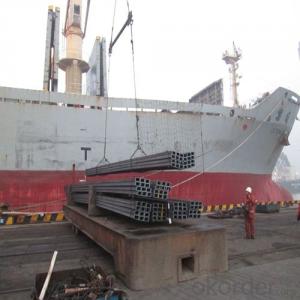Steel U Channel
- Loading Port:
- Xingang Port
- Payment Terms:
- TT or L/C
- Min Order Qty:
- 25 Tons m.t.
- Supply Capability:
- 1000 Tons Per Day m.t./month
OKorder Service Pledge
OKorder Financial Service
You Might Also Like
Specifications of Steel U Channel:
Standard Applied: GB Standard, EN Standard(UPN), JIS Standard
Sizes: 50mm to 300mm
Material Grade: Q235B, Q345B, S235JR, SS400, ASTM A36
As shown in the figure:
|
JIS U CHANNEL |
Standard h |
Sectional b |
Dimension s |
t |
Mass: Kg/m |
|
(mm) |
(mm) |
(mm) |
(mm) |
||
|
50x25 |
50 |
25 |
3.0 |
6.00 |
2.37 |
|
75X40 |
75 |
40 |
3.8 |
7.00 |
5.30 |
|
75X40 |
75 |
40 |
4.0 |
7.00 |
5.60 |
|
75X40 |
75 |
40 |
4.5 |
7.00 |
5.85 |
|
75X40 |
75 |
40 |
5.0 |
7.00 |
6.92 |
|
100X50 |
100 |
50 |
3.8 |
6.00 |
7.30 |
|
100X50 |
100 |
50 |
4.2 |
6.00 |
8.03 |
|
100X50 |
100 |
50 |
4.5 |
7.50 |
8.97 |
|
100X50 |
100 |
50 |
5.0 |
7.50 |
9.36 |
|
125X65 |
125 |
65 |
5.2 |
6.80 |
11.66 |
|
125X65 |
125 |
65 |
5.3 |
6.80 |
12.17 |
|
125X65 |
125 |
65 |
5.5 |
8.00 |
12.91 |
|
125X65 |
125 |
65 |
6.0 |
8.00 |
13.40 |
|
150x75 |
150 |
75 |
5.5 |
7.30 |
14.66 |
|
150x75 |
150 |
75 |
5.7 |
10.00 |
16.71 |
|
150x75 |
150 |
75 |
6.0 |
10.00 |
17.90 |
|
150x75 |
150 |
75 |
6.5 |
10.00 |
18.60 |
Note: We are able to supply other dimensions and sizes, which depends on the customer's requirements for the quantity.
Chemical Composition of Q235B Steel U Channel:
|
Alloy No |
Grade |
Element(%) | ||||
|
C |
Mn |
S |
P |
Si | ||
|
Q235 |
B |
0.12-0.20 |
0.3-0.7 |
≦0.045 |
≦0.045 |
≦0.3 |
Physical Properties of Q235B Steel U Channel:
|
Grade |
Yielding Strength Point(Mpa) | ||||
|
Q235B |
Thickness(mm) | ||||
|
≦16 |
>16-40 |
>40-60 |
>60-100 | ||
|
≧235 |
≧225 |
≧215 |
≧205 | ||
|
Tensile Strength(Mpa) |
Elongation After Fracture(%) | ||||
|
Thickness(mm) | |||||
|
≦16 |
>16-40 |
>40-60 |
>60-100 | ||
|
375-500 |
≧26 |
≧25 |
≧24 |
≧23 | |
Usage/Application of Steel U Channel:
The steel u channel can be applied to construction of warehouses, workshops, sport stadiums and car parks etc. In details, the steel u channel belongs to carbon structural steel which is applied to in the field of construction and machinery. The steel u channel is usually used for arch-itechtural structure, and they could be welded in order to support or hang a vari-ety of facilities. They are also usually used in combination with I beam. Generally,the steel u channel must possess perfect welding property, riveting property and mechanical property and so on.
Package & Delivery: Steel U Channel
The steel u channel will be packed in bundle with steel wire at each end of every bundle and color marking in order to help the customer to recognize his goods more easily at sight.
And steel u channel could be loaded into 20ft or 40ft container, or by bulk cargo. If the weight of each bundle reaches less than 3.5 mt, the loading by break bulk cargo should be choosed. When the weight of each bundle reaches less than 3mt, the loading by container should be choosed.
As for the transportaion from mill to loading port, the truck will be usually used. And the maximum quantity for each truck is 40mt.
All in all, we could do in accordance with customer's request
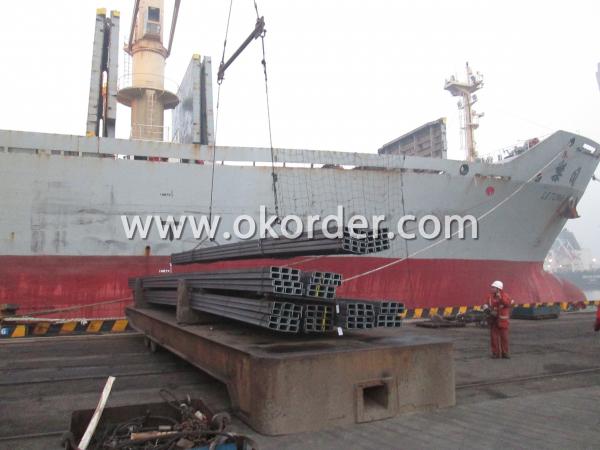
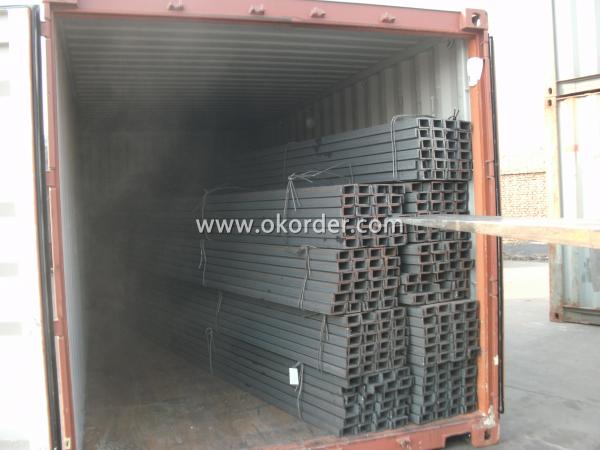
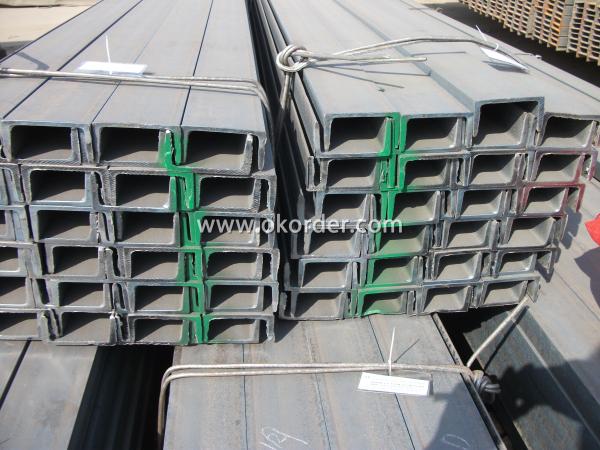
Production Flow of Steel U Channel:
1.The steel billet shall be heated in the high temperature furnace.
2. The heated steel billet shall be rolled five to nine times with the aim of shaping the general figure of steel u channel.
3. The rolled steel u channel should be put onto the cooling bed to make the temperature low.
4. The steel u channel should be straighted on the straightener.
5. The straighted steel u channel will be cut into meters by saw, as per customer's requirements.
- Q:What are the different types of connections used for steel channels in curtain wall systems?
- Steel channels in curtain wall systems can be connected using various methods to ensure structural integrity and performance. The following are some commonly used connection types: 1. Welded Connections: Steel channels are joined together by welding, providing excellent strength and rigidity. This type of connection is ideal for high-rise buildings or structures requiring maximum load-bearing capacity. 2. Bolted Connections: Bolts and nuts are used to secure the steel channels, allowing for easy installation and disassembly. This flexibility makes bolted connections suitable for situations requiring frequent adjustments or modifications. 3. Clamped Connections: Clamps or brackets hold the steel channels in place, enabling quick installation without drilling or welding. Clamped connections are convenient for temporary structures or buildings with frequent changes. 4. Adhesive Connections: High-strength adhesives or epoxy bond the steel channels, providing excellent load transfer and even stress distribution. Adhesive connections are used in curtain wall systems where a seamless appearance or aesthetics are a priority. 5. Combination Connections: Sometimes, a combination of different connection types is used to achieve optimal performance. For instance, a curtain wall system may employ both welded and bolted connections to provide strength and flexibility. Combination connections are common in complex or specialized curtain wall systems with specific load-bearing requirements. It is important to consider factors such as structural requirements, building codes, design considerations, and installation constraints when selecting a connection type. Consulting with a structural engineer or curtain wall specialist is crucial for determining the most suitable connection type for a specific curtain wall system.
- Q:What are the typical finishes available for steel channels?
- The typical finishes available for steel channels include hot-dip galvanized, powder coated, painted, and bare steel.
- Q:Can steel channels be used for supporting heavy equipment?
- Yes, steel channels can be used for supporting heavy equipment. Steel channels are known for their strength and load-bearing capacity, making them suitable for supporting heavy loads. They provide stability and structural support, making them a reliable choice for supporting heavy equipment in various industries such as construction, manufacturing, and transportation.
- Q:Can steel channels be used in marine environments?
- Indeed, steel channels have the potential to serve in marine environments. Nonetheless, it is imperative to carefully select the suitable steel variant and employ effective measures to guard against corrosion to guarantee their extended lifespan and optimal functionality in such settings. Marine environments are renowned for their elevated levels of moisture, exposure to saltwater, and corrosive elements, all of which can expedite the corrosion process and deterioration of metals. When it comes to selecting steel channels for marine applications, it is advisable to opt for materials that possess high resistance to corrosion, such as stainless steel or galvanized steel. Stainless steel, in particular, boasts exceptional corrosion resistance, making it highly capable of enduring the harsh conditions prevalent in marine environments. Conversely, galvanized steel is equipped with a protective zinc coating that serves as a barrier against corrosion. Moreover, it is of utmost importance to adopt appropriate maintenance and inspection practices to promptly identify and address any indications of corrosion or damage. Regular cleansing, eradication of marine growth, and application of protective coatings can significantly prolong the lifespan of steel channels in marine environments. In conclusion, although steel channels can be utilized in marine environments, it is vital to meticulously choose the appropriate steel variant and implement effective corrosion protection measures to ensure their resilience and effectiveness in these demanding conditions.
- Q:How do steel channels contribute to building aesthetics?
- Building aesthetics can be enhanced in several ways by incorporating steel channels. Firstly, these channels serve as structural elements, providing strength and stability to the overall structure. However, they also play a significant role in improving the visual appeal of a building. One of the primary ways steel channels contribute to building aesthetics is through their sleek and contemporary appearance. With their clean lines and smooth surface, steel channels can give a building a modern and sophisticated look. They can be utilized in a range of architectural designs, from industrial to minimalist, adding a touch of elegance and refinement to the overall aesthetic. Furthermore, steel channels offer great versatility in terms of design possibilities. Architects and designers can easily customize and fabricate them into various shapes and sizes, allowing for the creation of unique and visually striking elements. Steel channels can be employed as decorative features like handrails, balustrades, or window frames, thereby adding visual interest and architectural detailing to the building. Moreover, steel channels can be finished with different coatings or treatments to further enhance their aesthetic appeal. They can be painted in various colors to complement the overall design scheme or left exposed, showcasing the natural beauty of steel. Additionally, they can be polished or brushed to achieve different textures and finishes, thereby adding depth and character to the building's appearance. Furthermore, steel channels can contribute to the aesthetics of a building by creating a sense of openness and transparency. When used as structural elements in facades, they can support large glass panels, allowing for expansive views and the entry of natural light into the building. This creates a visually pleasing and inviting atmosphere, connecting the interior spaces with the surrounding environment. In conclusion, steel channels enhance building aesthetics by providing a sleek and contemporary appearance, offering design versatility, enabling customization, and creating a sense of openness. With their clean lines, smooth surface, and various finishing options, steel channels can elevate the visual appeal of a building, adding elegance, sophistication, and architectural detailing to the overall design.
- Q:Can steel channels be used in the agricultural parts manufacturing industry?
- Yes, steel channels can be used in the agricultural parts manufacturing industry. Steel channels are versatile and strong, making them suitable for various applications in the agricultural sector. They can be utilized to manufacture structural components, such as support beams, frames, or braces for agricultural equipment like tractors, harvesters, or irrigation systems. Steel channels provide excellent strength and durability, allowing them to withstand heavy loads and harsh environmental conditions often found in agricultural settings. Additionally, steel channels can be easily fabricated, welded, and customized to meet specific requirements, making them a practical choice for agricultural parts manufacturing.
- Q:Are steel channels suitable for the oil and gas industry?
- Yes, steel channels are suitable for the oil and gas industry. They offer high strength, durability, and corrosion resistance, making them ideal for various applications such as structural support, piping systems, and equipment fabrication in the oil and gas sector.
- Q:What are the aesthetic options for steel channels?
- There are several aesthetic options available for steel channels, including different finishes such as polished, brushed, or painted surfaces. Additionally, steel channels can be customized with decorative patterns, textures, or etchings, providing further aesthetic choices.
- Q:What kind of steel products are there, such as channel steel, angle iron and so on?
- Common types of wire Q195, Q215, Q235 three, but the construction of steel wire rod for only Q215, Q235 two, general specifications often with diameter 6.5mm, diameter 8.0mm, diameter 10mm, the country's largest diameter of wire rod can reach 30mm. Besides being used as reinforcing bars for building reinforced concrete, wire rod can also be used for wire drawing and wire mesh.
- Q:Are steel channels suitable for solar panel installations?
- Yes, steel channels are suitable for solar panel installations. They provide a strong and durable framework to support the solar panels, ensuring stability and longevity. Additionally, steel channels offer flexibility in design and can be easily customized to fit specific installation requirements.
1. Manufacturer Overview |
|
|---|---|
| Location | Hebei, China |
| Year Established | 1993 |
| Annual Output Value | Above US$100 Million |
| Main Markets | South Asia Middle East; Southeast Aisa; south Korea |
| Company Certifications | ISO 9001:2000 |
2. Manufacturer Certificates |
|
|---|---|
| a) Certification Name | |
| Range | |
| Reference | |
| Validity Period | |
3. Manufacturer Capability |
|
|---|---|
| a)Trade Capacity | |
| Nearest Port | Tianjin; |
| Export Percentage | 1% - 10% |
| No.of Employees in Trade Department | 11-20 People |
| Language Spoken: | English; Chinese |
| b)Factory Information | |
| Factory Size: | Above 20,000 square meters |
| No. of Production Lines | 1 |
| Contract Manufacturing | OEM service offered |
| Product Price Range | average |
Send your message to us
Steel U Channel
- Loading Port:
- Xingang Port
- Payment Terms:
- TT or L/C
- Min Order Qty:
- 25 Tons m.t.
- Supply Capability:
- 1000 Tons Per Day m.t./month
OKorder Service Pledge
OKorder Financial Service
Similar products
New products
Hot products
Hot Searches
Related keywords










